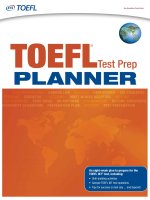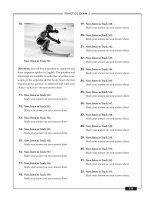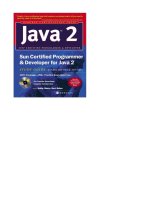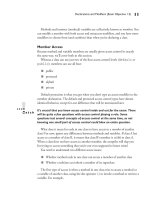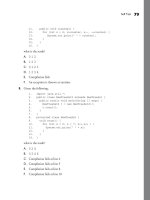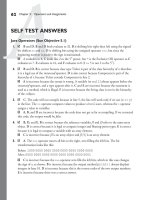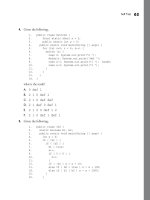SAT math 2 subject test prep SAT math level 2 study guide
Bạn đang xem bản rút gọn của tài liệu. Xem và tải ngay bản đầy đủ của tài liệu tại đây (9.77 MB, 187 trang )
FREE Test Taking Tips DVD
Offer
To help us better serve you, we have developed a Test Taking Tips DVD
that we would like to give you for FREE. This DVD covers world-class
test taking tips that you can use to be even more successful when you
are taking your test.
All that we ask is that you email us your feedback about your study guide.
Please let us know what you thought about it – whether that is good, bad or
indifferent.
To get your FREE Test Taking Tips DVD, email
with “FREE DVD” in the subject line and
the following information in the body of the email:
2
a. The title of your study guide.
b. Your product rating on a scale of 1-5, with 5 being the highest
rating.
c. Your feedback about the study guide. What did you think of it?
d. Your full name and shipping address to send your free DVD.
If you have any questions or concerns, please don’t hesitate to contact us at
Thanks again!
3
SAT Math 2 Subject
Test Prep
SAT Math Level 2 Study
Guide
Test Prep Books Math Prep Team
4
Copyright © 2018 Test Prep Books Math Prep Team
All rights reserved.
5
Table of Contents
Quick Overview
Test-Taking Strategies
FREE DVD OFFER
Introduction
Number and Operations
Practice Questions
Answer Explanations
Algebra and Functions
Practice Questions
Answer Explanations
Geometry and Measurement
Practice Questions
Answer Explanations
Data Analysis, Statistics, and Probability
Practice Questions
Answer Explanations
6
Quick Overview
As you draw closer to taking your exam, effective preparation becomes
more and more important. Thankfully, you have this study guide to help
you get ready. Use this guide to help keep your studying on track and refer
to it often.
This study guide contains several key sections that will help you be
successful on your exam. The guide contains tips for what you should do
the night before and the day of the test. Also included are test-taking tips.
Knowing the right information is not always enough. Many well-prepared
test takers struggle with exams. These tips will help equip you to
accurately read, assess, and answer test questions.
A large part of the guide is devoted to showing you what content to expect
on the exam and to helping you better understand that content. Near the
end of this guide is a practice test so that you can see how well you have
grasped the content. Then, answer explanations are provided so that you
can understand why you missed certain questions.
Don’t try to cram the night before you take your exam. This is not a wise
strategy for a few reasons. First, your retention of the information will be
low. Your time would be better used by reviewing information you already
know rather than trying to learn a lot of new information. Second, you will
likely become stressed as you try to gain a large amount of knowledge in a
short amount of time. Third, you will be depriving yourself of sleep. So be
sure to go to bed at a reasonable time the night before. Being well-rested
helps you focus and remain calm.
Be sure to eat a substantial breakfast the morning of the exam. If you are
taking the exam in the afternoon, be sure to have a good lunch as well.
Being hungry is distracting and can make it difficult to focus. You have
hopefully spent lots of time preparing for the exam. Don’t let an empty
stomach get in the way of success!
When travelling to the testing center, leave earlier than needed. That way,
you have a buffer in case you experience any delays. This will help you
remain calm and will keep you from missing your appointment time at the
testing center.
Be sure to pace yourself during the exam. Don’t try to rush through the
exam. There is no need to risk performing poorly on the exam just so you
can leave the testing center early. Allow yourself to use all of the allotted
7
time if needed.
Remain positive while taking the exam even if you feel like you are
performing poorly. Thinking about the content you should have mastered
will not help you perform better on the exam.
Once the exam is complete, take some time to relax. Even if you feel that
you need to take the exam again, you will be well served by some down
time before you begin studying again. It’s often easier to convince yourself
to study if you know that it will come with a reward!
8
Test-Taking Strategies
1. Predicting the Answer
When you feel confident in your preparation for a multiple-choice test, try
predicting the answer before reading the answer choices. This is especially
useful on questions that test objective factual knowledge or that ask you to
fill in a blank. By predicting the answer before reading the available
choices, you eliminate the possibility that you will be distracted or led
astray by an incorrect answer choice. You will feel more confident in your
selection if you read the question, predict the answer, and then find your
prediction among the answer choices. After using this strategy, be sure to
still read all of the answer choices carefully and completely. If you feel
unprepared, you should not attempt to predict the answers. This would be a
waste of time and an opportunity for your mind to wander in the wrong
direction.
2. Reading the Whole Question
Too often, test takers scan a multiple-choice question, recognize a few
familiar words, and immediately jump to the answer choices. Test authors
are aware of this common impatience, and they will sometimes prey upon
it. For instance, a test author might subtly turn the question into a negative,
or he or she might redirect the focus of the question right at the end. The
only way to avoid falling into these traps is to read the entirety of the
question carefully before reading the answer choices.
3. Looking for Wrong Answers
Long and complicated multiple-choice questions can be intimidating. One
way to simplify a difficult multiple-choice question is to eliminate all of
the answer choices that are clearly wrong. In most sets of answers, there
will be at least one selection that can be dismissed right away. If the test is
administered on paper, the test taker could draw a line through it to
indicate that it may be ignored; otherwise, the test taker will have to
perform this operation mentally or on scratch paper. In either case, once
the obviously incorrect answers have been eliminated, the remaining
choices may be considered. Sometimes identifying the clearly wrong
answers will give the test taker some information about the correct answer.
For instance, if one of the remaining answer choices is a direct opposite of
one of the eliminated answer choices, it may well be the correct answer.
The opposite of obviously wrong is obviously right! Of course, this is not
always the case. Some answers are obviously incorrect simply because
9
they are irrelevant to the question being asked. Still, identifying and
eliminating some incorrect answer choices is a good way to simplify a
multiple-choice question.
4. Don’t Overanalyze
Anxious test takers often overanalyze questions. When you are nervous,
your brain will often run wild, causing you to make associations and
discover clues that don’t actually exist. If you feel that this may be a
problem for you, do whatever you can to slow down during the test. Try
taking a deep breath or counting to ten. As you read and consider the
question, restrict yourself to the particular words used by the author. Avoid
thought tangents about what the author really meant, or what he or she was
trying to say. The only things that matter on a multiple-choice test are the
words that are actually in the question. You must avoid reading too much
into a multiple-choice question, or supposing that the writer meant
something other than what he or she wrote.
5. No Need for Panic
It is wise to learn as many strategies as possible before taking a multiplechoice test, but it is likely that you will come across a few questions for
which you simply don’t know the answer. In this situation, avoid
panicking. Because most multiple-choice tests include dozens of questions,
the relative value of a single wrong answer is small. Moreover, your
failure on one question has no effect on your success elsewhere on the test.
As much as possible, you should compartmentalize each question on a
multiple-choice test. In other words, you should not allow your feelings
about one question to affect your success on the others. When you find a
question that you either don’t understand or don’t know how to answer,
just take a deep breath and do your best. Read the entire question slowly
and carefully. Try rephrasing the question a couple of different ways.
Then, read all of the answer choices carefully. After eliminating obviously
wrong answers, make a selection and move on to the next question.
6. Confusing Answer Choices
When working on a difficult multiple-choice question, there may be a
tendency to focus on the answer choices that are the easiest to understand.
Many people, whether consciously or not, gravitate to the answer choices
that require the least concentration, knowledge, and memory. This is a
mistake. When you come across an answer choice that is confusing, you
should give it extra attention. A question might be confusing because you
10
do not know the subject matter to which it refers. If this is the case, don’t
eliminate the answer before you have affirmatively settled on another.
When you come across an answer choice of this type, set it aside as you
look at the remaining choices. If you can confidently assert that one of the
other choices is correct, you can leave the confusing answer aside.
Otherwise, you will need to take a moment to try to better understand the
confusing answer choice. Rephrasing is one way to tease out the sense of a
confusing answer choice.
7. Your First Instinct
Many people struggle with multiple-choice tests because they overthink
the questions. If you have studied sufficiently for the test, you should be
prepared to trust your first instinct once you have carefully and completely
read the question and all of the answer choices. There is a great deal of
research suggesting that the mind can come to the correct conclusion very
quickly once it has obtained all of the relevant information. At times, it
may seem to you as if your intuition is working faster even than your
reasoning mind. This may in fact be true. The knowledge you obtain while
studying may be retrieved from your subconscious before you have a
chance to work out the associations that support it. Verify your instinct by
working out the reasons that it should be trusted.
8. Key Words
Many test takers struggle with multiple-choice questions because they
have poor reading comprehension skills. Quickly reading and
understanding a multiple-choice question requires a mixture of skill and
experience. To help with this, try jotting down a few key words and
phrases on a piece of scrap paper. Doing this concentrates the process of
reading and forces the mind to weigh the relative importance of the
question’s parts. In selecting words and phrases to write down, the test
taker thinks about the question more deeply and carefully. This is
especially true for multiple-choice questions that are preceded by a long
prompt.
9. Subtle Negatives
One of the oldest tricks in the multiple-choice test writer’s book is to
subtly reverse the meaning of a question with a word like not or except. If
you are not paying attention to each word in the question, you can easily
be led astray by this trick. For instance, a common question format is,
“Which of the following is…?” Obviously, if the question instead is,
11
“Which of the following is not…?,” then the answer will be quite different.
Even worse, the test makers are aware of the potential for this mistake and
will include one answer choice that would be correct if the question were
not negated or reversed. A test taker who misses the reversal will find what
he or she believes to be a correct answer and will be so confident that he or
she will fail to reread the question and discover the original error. The only
way to avoid this is to practice a wide variety of multiple-choice questions
and to pay close attention to each and every word.
10. Reading Every Answer Choice
It may seem obvious, but you should always read every one of the answer
choices! Too many test takers fall into the habit of scanning the question
and assuming that they understand the question because they recognize a
few key words. From there, they pick the first answer choice that answers
the question they believe they have read. Test takers who read all of the
answer choices might discover that one of the latter answer choices is
actually more correct. Moreover, reading all of the answer choices can
remind you of facts related to the question that can help you arrive at the
correct answer. Sometimes, a misstatement or incorrect detail in one of the
latter answer choices will trigger your memory of the subject and will
enable you to find the right answer. Failing to read all of the answer
choices is like not reading all of the items on a restaurant menu: you might
miss out on the perfect choice.
11. Spot the Hedges
One of the keys to success on multiple-choice tests is paying close
attention to every word. This is never more true than with words like
almost, most, some, and sometimes. These words are called “hedges”
because they indicate that a statement is not totally true or not true in every
place and time. An absolute statement will contain no hedges, but in many
subjects, like literature and history, the answers are not always
straightforward or absolute. There are always exceptions to the rules in
these subjects. For this reason, you should favor those multiple-choice
questions that contain hedging language. The presence of qualifying words
indicates that the author is taking special care with his or her words, which
is certainly important when composing the right answer. After all, there
are many ways to be wrong, but there is only one way to be right! For this
reason, it is wise to avoid answers that are absolute when taking a
multiple-choice test. An absolute answer is one that says things are either
all one way or all another. They often include words like every, always,
12
best, and never. If you are taking a multiple-choice test in a subject that
doesn’t lend itself to absolute answers, be on your guard if you see any of
these words.
12. Long Answers
In many subject areas, the answers are not simple. As already mentioned,
the right answer often requires hedges. Another common feature of the
answers to a complex or subjective question are qualifying clauses, which
are groups of words that subtly modify the meaning of the sentence. If the
question or answer choice describes a rule to which there are exceptions or
the subject matter is complicated, ambiguous, or confusing, the correct
answer will require many words in order to be expressed clearly and
accurately. In essence, you should not be deterred by answer choices that
seem excessively long. Oftentimes, the author of the text will not be able
to write the correct answer without offering some qualifications and
modifications. Your job is to read the answer choices thoroughly and
completely and to select the one that most accurately and precisely
answers the question.
13. Restating to Understand
Sometimes, a question on a multiple-choice test is difficult not because of
what it asks but because of how it is written. If this is the case, restate the
question or answer choice in different words. This process serves a couple
of important purposes. First, it forces you to concentrate on the core of the
question. In order to rephrase the question accurately, you have to
understand it well. Rephrasing the question will concentrate your mind on
the key words and ideas. Second, it will present the information to your
mind in a fresh way. This process may trigger your memory and render
some useful scrap of information picked up while studying.
14. True Statements
Sometimes an answer choice will be true in itself, but it does not answer
the question. This is one of the main reasons why it is essential to read the
question carefully and completely before proceeding to the answer
choices. Too often, test takers skip ahead to the answer choices and look
for true statements. Having found one of these, they are content to select it
without reference to the question above. Obviously, this provides an easy
way for test makers to play tricks. The savvy test taker will always read
the entire question before turning to the answer choices. Then, having
settled on a correct answer choice, he or she will refer to the original
13
question and ensure that the selected answer is relevant. The mistake of
choosing a correct-but-irrelevant answer choice is especially common on
questions related to specific pieces of objective knowledge, like historical
or scientific facts. A prepared test taker will have a wealth of factual
knowledge at his or her disposal, and should not be careless in its
application.
15. No Patterns
One of the more dangerous ideas that circulates about multiple-choice tests
is that the correct answers tend to fall into patterns. These erroneous ideas
range from a belief that B and C are the most common right answers, to
the idea that an unprepared test-taker should answer “A-B-A-C-A-D-A-BA.” It cannot be emphasized enough that pattern-seeking of this type is
exactly the WRONG way to approach a multiple-choice test. To begin
with, it is highly unlikely that the test maker will plot the correct answers
according to some predetermined pattern. The questions are scrambled and
delivered in a random order. Furthermore, even if the test maker was
following a pattern in the assignation of correct answers, there is no reason
why the test taker would know which pattern he or she was using. Any
attempt to discern a pattern in the answer choices is a waste of time and a
distraction from the real work of taking the test. A test taker would be
much better served by extra preparation before the test than by reliance on
a pattern in the answers.
14
FREE DVD OFFER
Don’t forget that doing well on your exam includes both understanding the
test content and understanding how to use what you know to do well on
the test. We offer a completely FREE Test Taking Tips DVD that covers
world class test taking tips that you can use to be even more successful
when you are taking your test.
All that we ask is that you email us your feedback about your study guide.
To get your FREE Test Taking Tips DVD, email
with “FREE DVD” in the subject line and
the following information in the body of the email:
The title of your study guide.
Your product rating on a scale of 1-5, with 5 being the highest rating.
Your feedback about the study guide. What did you think of it?
Your full name and shipping address to send your free DVD.
15
Introduction
Function of the Test
The Mathematics Level 2 Subject Test is a test that examines your
knowledge of geometry, algebra, trigonometry, and precalculus in order to
showcase your abilities through college admissions. Some colleges use
Mathematics 2 to place students in appropriate courses in college, allowing
them to pass over the basics into more complex courses. Note that in New
York State, some people may use SAT Subject Test scores as a substitute
for a Regents examination score. The Mathematics Level 2 Subject Test
examines your knowledge of mathematics within a two-year period of
algebra and a one-year period of geometry, with the additional familiarity
of trigonometry or precalculus.
Test Administration
To find out where the Mathematics Level 2 Subject Test is given, go to the
website at collegereadiness.collegeboard.org. There you can find exam
dates for the current year as well as up to three years in advance. The dates
are listed by subject and give a deadline to register for each date.
Currently, there are six dates listed each year for taking the subject tests,
all of which offer the Mathematics 2 subject test. The dates for the exams
are offered in August, October, November, December, May, and June.
Note that you cannot take the SAT and an SAT Subject Test on the same
date. The College Board website also has a test date finder, where you
enter in the test date and your country, state, and city. The results bring up
testing centers in your area or the area(s) nearest you.
Test Format
The Mathematics Level 2 Subject test is sixty minutes long and has fifty
multiple choice questions. The skills that are needed in order to be
successful on the exam are numbers and operations; algebra and functions;
geometry and measurement; and statistics, probability, and data analysis.
The test sections are divided according to percentages in the table below:
Content
Approximate %
of Test
10 to 14%
48 to 52%
48 to 52%
(10 to 14%)
Number and operations
Algebra and functions
Geometry and measurement
(Coordinate)
16
(Three-dimensional)
(Trigonometry)
Data analysis, statistics and
probability
(4 to 6%)
(12 to 16%)
8 to 12%
Note that the difference between Mathematics I and Mathematics II is that
Mathematics II is for test takers who are adept in the subjects of
trigonometry or precalculus and know how to use a graphing calculator. In
order to decide between the two tests, take a look at which subjects you are
recently familiar with and what college programs you are most interested
in.
Test takers are allowed to bring calculators for the exam day. Keep in
mind that many of the answer choices on the Mathematics 2 exam are
rounded, so the calculator answer may not be the exact answer choice you
see on the exam. Remember to read each problem carefully and to not
jump at the very first number that matches an answer choice. Follow the
question through to the end.
Scoring
In 2016, 145,140 students took the Mathematics Level 2 Subject Test. Out
of a 200 to 800-point scale, the mean score was 690. The standard
deviation was 101; this calculates the spread of grades around the average
score. A “good score” for the Mathematics Level 2 Subject Test depends
on the college you are applying to. Although many colleges are flexible
and look at SAT scores along with other factors for admissions, highly
selective schools prefer to see a score in the 700s or above. Note that you
do not have to take SAT Subject Tests for admission to most colleges;
even many highly selective schools recommend but do not require the
exam.
Recent Developments
The only new developments for the subject tests are changes to the testing
calendar. A new test date is offered on Saturday, August 26, 2017. For
students who have to miss the Saturday test for religious reasons, the test is
also offered on Sunday, August 27. Exam dates are no longer offered in
January. March testing is available internationally, and subject tests will be
offered outside of the U.S. and U.S. territories in October, November,
December, May, and June.
17
18
Number and Operations
Structure of the Number System
The mathematical number system is made up of two general types of
numbers: real and complex. Real numbers are those that are used in
normal settings, while complex numbers are those composed of both a real
number and an imaginary one. Imaginary numbers are the result of taking
the square root of -1, and
.
The real number system is often explained using a Venn diagram similar to
the one below. After a number has been labeled as a real number, further
classification occurs when considering the other groups in this diagram. If
a number is a never-ending, non-repeating decimal, it falls in the irrational
category. Otherwise, it is rational. More information on these types of
numbers is provided in the previous section. Furthermore, if a number
does not have a fractional part, it is classified as an integer, such as -2, 75,
or zero. Whole numbers are an even smaller group that only includes
positive integers and zero. The last group of natural numbers is made up of
only positive integers, such as 2, 56, or 12.
Real numbers can be compared and ordered using the number line. If a
number falls to the left on the real number line, it is less than a number on
the right. For example,
because -2 falls to the left of zero, and 5
falls to the right. Numbers to the left of zero are negative while those to the
right are positive.
19
Complex numbers are made up of the sum of a real number and an
imaginary number. Some examples of complex numbers include
,
, and
. Adding and subtracting complex numbers is
similar to collecting like terms. The real numbers are added together, and
the imaginary numbers are added together. For example, if the problem
asks to simplify the expression
, the 6 and -3 are
combined to make 3, and the
and
combine to make . Multiplying
and dividing complex numbers is similar to working with exponents. One
rule to remember when multiplying is that
. For example, if a
problem asks to simplify the expression
distributed throughout the
and the
, the
should be
. This leaves the final expression
. The 28 is negative because
results in a negative number.
The last type of operation to consider with complex numbers is the
conjugate. The conjugate of a complex number is a technique used to
change the complex number into a real number. For example, the
conjugate of
is
. Multiplying
results in
, which has a final answer of
.
The order of operations—PEMDAS—simplifies longer expressions with
real or imaginary numbers. Each operation is listed in the order of how
they should be completed in a problem containing more than one
operation. Parenthesis can also mean grouping symbols, such as brackets
and absolute value. Then, exponents are calculated. Multiplication and
division should be completed from left to right, and addition and
subtraction should be completed from left to right.
Simplification of another type of expression occurs when radicals are
involved. As explained previously, root is another word for radical. For
example, the following expression is a radical that can be simplified:
. First, the number must be factored out to the highest perfect
square. Any perfect square can be taken out of a radical. Twenty-four can
be factored into 4 and 6, and 4 can be taken out of the radical.
be taken out, and 6 stays underneath. If
20
can
x can be taken out of the
radical because it is a perfect square. The simplified radical is
approximation can be found using a calculator.
. An
There are also properties of numbers that are true for certain operations.
The commutative property allows the order of the terms in an expression to
change while keeping the same final answer. Both addition and
multiplication can be completed in any order and still obtain the same
result. However, order does matter in subtraction and division. The
associative property allows any terms to be “associated” by parenthesis
and retain the same final answer. For example,
. Both addition and multiplication are
associative; however, subtraction and division do not hold this property.
The distributive property states that
It is a property
that involves both addition and multiplication, and the a is distributed onto
each term inside the parentheses.
Integers can be factored into prime numbers. To factor is to express as a
product. For example,
and
. Both are
factorizations, but the expression involving the factors of 3 and 2 is known
as a prime factorization because it is factored into a product of two prime
numbers—integers which do not have any factors other than themselves
and 1. A composite number is a positive integer that can be divided into at
least one other integer other than itself and 1, such as 6. Integers that have
a factor of 2 are even, and if they are not divisible by 2, they are odd.
Finally, a multiple of a number is the product of that number and a
counting number—also known as a natural number. For example, some
multiples of 4 are 4, 8, 12, 16, etc.
Basic Operations of Arithmetic
There are four different basic operations used with numbers: addition,
subtraction, multiplication, and division.
Addition takes two numbers and combines them into a total called
the sum. The sum is the total when combining two collections into
one. If there are 5 things in one collection and 3 in another, then after
combining them, there is a total of
. Note the order does not
matter when adding numbers. For example,
.
Subtraction is the opposite (or “inverse”) operation to addition.
Whereas addition combines two quantities together, subtraction takes
21
one quantity away from another. For example, if there are 20 gallons
of fuel and 5 are removed, that gives
gallons remaining.
Note that for subtraction, the order does matter because it makes a
difference which quantity is being removed from which.
Multiplication is repeated addition.
can be thought of as
putting together 3 sets of items, each set containing 4 items. The total
is 12 items. Another way to think of this is to think of each number
as the length of one side of a rectangle. If a rectangle is covered in
tiles with 3 columns of 4 tiles each, then there are 12 tiles in total.
From this, one can see that the answer is the same if the rectangle
has 4 rows of 3 tiles each:
. By expanding this reasoning,
the order the numbers are multiplied does not matter.
Division is the opposite of multiplication. It means taking one
quantity and dividing it into sets the size of the second quantity. If
there are 16 sandwiches to be distributed to 4 people, then each
person gets
sandwiches. As with subtraction, the order in
which the numbers appear does matter for division.
Addition
Addition is the combination of two numbers so their quantities are added
together cumulatively. The sign for an addition operation is the + symbol.
For example, 9 + 6 = 15. The 9 and 6 combine to achieve a cumulative
value, called a sum.
Addition holds the commutative property, which means that numbers in an
addition equation can be switched without altering the result. The formula
for the commutative property is a + b = b + a. Let's look at a few examples
to see how the commutative property works:
Addition also holds the associative property, which means that the
grouping of numbers doesn’t matter in an addition problem. In other
words, the presence or absence of parentheses is irrelevant. The formula
for the associative property is
some examples of the associative property at work:
22
Here are
Subtraction
Subtraction is taking away one number from another, so their quantities
are reduced. The sign designating a subtraction operation is the – symbol,
and the result is called the difference. For example,
. The
number 6 detracts from the number 9 to reach the difference 3.
Unlike addition, subtraction follows neither the commutative nor
associative properties. The order and grouping in subtraction impact the
result.
When working through subtraction problems involving larger numbers,
it’s necessary to regroup the numbers. Let's work through a practice
problem using regrouping:
Here, it is clear that the ones and tens columns for 77 are greater than the
ones and tens columns for 325. To subtract this number, borrow from the
tens and hundreds columns. When borrowing from a column, subtracting 1
from the lender column will add 10 to the borrower column:
After ensuring that each digit in the top row is greater than the digit in the
corresponding bottom row, subtraction can proceed as normal, and the
answer is found to be 248.
Multiplication
23
Multiplication involves adding together multiple copies of a number. It is
indicated by an ´ symbol or a number immediately outside of a
parenthesis. For example:
The two numbers being multiplied together are called factors, and their
result is called a product. For example,
alternatively by expansion of either the 9 or the 6:
. This can be shown
Like addition, multiplication holds the commutative and associative
properties:
Multiplication also follows the distributive property, which allows the
multiplication to be distributed through parentheses. The formula for
distribution is
examples:
This is clear after the
Multiplication becomes slightly more complicated when multiplying
numbers with decimals. The easiest way to answer these problems is to
ignore the decimals and multiply as if they were whole numbers. After
multiplying the factors, place a decimal in the product. The placement of
the decimal is determined by taking the cumulative number of decimal
places in the factors.
For example:
24
Let's tackle the first example. First, ignore the decimal and multiply the
numbers as though they were whole numbers to arrive at a product: 21.
Second, count the number of digits that follow a decimal (one). Finally,
move the decimal place that many positions to the left, as the factors have
only one decimal place. The second example works the same way, except
that there are two total decimal places in the factors, so the product's
decimal is moved two places over. In the third example, the decimal
should be moved over two digits, but the digit zero is no longer needed, so
it is erased and the final answer is 9.6.
Division
Division and multiplication are inverses of each other in the same way that
addition and subtraction are opposites. The signs designating a division
operation are the
and / symbols. In division, the second number
divides into the first.
The number before the division sign is called the dividend or, if expressed
as a fraction, the numerator. For example, in
, a is the dividend,
while in , a is the numerator.
The number after the division sign is called the divisor or, if expressed as a
fraction, the denominator. For example, in
, b is the divisor, while
in , b is the denominator.
Like subtraction, division doesn’t follow the commutative property, as it
matters which number comes before the division sign, and division doesn’t
follow the associative or distributive properties for the same reason.
For example:
If a divisor doesn’t divide into a dividend an integer number of times,
whatever is left over is termed the remainder. The remainder can be further
25

